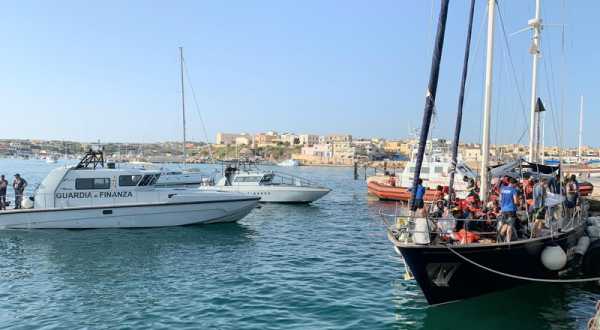
The EU must change direction to achieve its migration objectives in the Mediterranean, write James Dennison and Andrew Geddes.
Dr James Dennison is a part-time professor at Migration Policy Centre, European University Institute; Professor Andrew Geddes is the Director of the Migration Policy Centre.
If the only tool you have is a hammer then it is tempting to treat everything as if it were a nail, wrote the American psychologist Abraham Maslow. This became known as the law of the hammer: cognitive bias that can lead to an over reliance on a single tool, which ends up being counter-productive.
The EU has become the migratory hegemon in the Mediterranean, but when looking at EU approaches over the last 20 years or so, migration flows seem to look very much like a nail and the EU has a very big hammer.
With eyes turned to the geo-political effects of the Russian invasion of Ukraine, conditions are rife for dangerous policy drift where the EU doubles down on familiar approaches of reinforced border security, breaking the ‘business model’ of smugglers and returning irregularly arriving migrants. The 23,000 people reported dead or missing in the Mediterranean since 2015 are a tragic indication that these approaches have not worked. Relying on them in the future may well not work either.
As with most historic hegemons, the EU is understandably reluctant to fully adopt its role. Doing so requires taking responsibility for matters of life and death, including the conditions of migrants, smuggling and trafficking, the logistical and legal burdens of migration management, and balancing the demands from both sides of the Mediterranean. With the immigration issue partially “Europeanised”, the EU risks more than ever being simultaneously characterised by critics as “Fortress Europe”, on the one hand, and “l’Europe passoire”, on the other.
The EU emerged from the 2015-16 “migration crisis”, if not stronger, then certainly more empowered. A key metric of empowerment is financial. For example, the EU’s annual budget for its border force—Frontex—continues to rise, up 430% since 2015 while its post-2015 “Emergency Trust Fund for Africa” has already spent €5 billion addressing “root causes of migration”.
To meet its challenges, the EU will have to lean into its inevitable role by developing three approaches. First, an effective strategic approach requires regional partnerships. Despite large amounts of funding, the EU’s migration management remains characterised by a lack of harmonisation, crisis management tendencies, and standalone projects aimed only at member state priorities that do not gain the broader buy-in necessary for effectiveness.
The EU should capitalise on existing dialogue frameworks to create permanent forums in the Mediterranean that are flexible enough to respond to changing priorities and facilitate shared information, capacity, and innovation. Via ongoing engagement, this can lead to a common approach and eventually common policy consensus around regularity, safety, and rights. This would have the potential to unlock the renewed approach to migration called for by the Agenda for the Mediterranean.
In contrast, recent strategies and policy objectives put in place by the EU are internal, with third countries—the supposed recipients of actions—not involved in formulation. The results of that and the current approach of pouring money into border management and security will remain suboptimal for those of all political persuasions so long as policy objectives are not shared across the Mediterranean.
Second, meeting its migration objectives will require harmonisation, coherence of approach, and an increase in impact assessment, rather than simple expenditure that, in the context of COVID and Ukraine, will be hard to maintain.
As border management continues to become more expansive, complex, contested, and diffuse, it is increasingly done both before and after physical borders, which requires informing and influencing publics and would-be migrants. As such, meeting objectives on regular and safe options, safety, smuggling, trafficking, and irregularity, return and reintegration, and public confidence requires effective strategic communication, in addition to simply training staff and buying equipment. This requires other actors, skills, and actions, not least investment in data on propensity to migrate both regularly and irregularly, including the motivational, values profiles of target audiences to design effective interventions.
Similarly, the Trust Fund and assisted voluntary return and reintegration (AVRR) is a welcome departure from forced returns, but based on questionable assumptions of economic drivers, resulting in questionable efficacy and some eyewatering expenditure-to-reintegration ratios.
Finally, impact assessments of projects are either not done at all, left until too late, or so byzantine as to be detached from on-the-ground reality, unintelligible, and thus a waste of resources. By having a harmonised process built on first principles and integrated into broad policy programmes from the start, impact assessments would improve scrutiny by the European Parliament, member states, and the public and thus confidence in the Commission.
Third, for the EU to be effective, multi-level governance involving cities and local authorities on both sides of the Mediterranean, rather than working only at the national level, is inescapable. Despite national competences, cities already deal with the day-to-day of integration, return and re-integration, and above all access to services, additionally making them sources of information to both the EU and those the EU wishes to influence.
The law of the hammer has led to a fixation on specific tools in EU migration management that have had difficulty achieving their objectives and securing wider buy-in required by genuine partnership. An empowered EU can create a conducive environment to dialogue and common policy goals, more sophisticated use of funds, and multi-level partnerships to achieve its own migration objectives while retaining internal and external confidence in the Mediterranean in a global context of growing threats.
Source: euractiv.com



